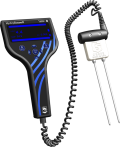
長期モニタリング向けに設計






概要
CS616は、多孔質媒体(土壌など)の体積含水率(VWC)を0%から飽和まで測定します。このプローブはメガヘルツ振動周波数を出力し、スケールダウンしてCampbell Scientificのデータロガーで容易に読み取ることができます。
続きを読む利点と特徴
- ほとんどのCampbell Scientificデータロガーに対応
- 高精度、正確
- 高速応答
- 長期の無人モニタリング用に設計
- AM16/32シリーズマルチプレクサと互換性があり、複数のセンサを測定可能
- プローブロッドは任意の方向に埋め込むことが可能
イメージ

詳細
応答特性
CS616のロッドに沿って伝播する信号は、土壌溶液中の遊離イオンと土壌鉱物の導電性成分によって減衰されます。ほとんどのアプリケーションでは、減衰は水分含有量の変化に対するCS616の応答に影響を与えるほどではなく、応答は出荷時の標準キャリブレーションによって詳細に計測されています。ただし、土壌の電気伝導率が比較的高い土壌、圧縮された土壌、または粘土含有量の高い土壌では、特定の媒体(土壌)に合わせてキャリブレーションをする必要があります。これらの調整を行うためのガイダンスは、取扱説明書に記載されています。
仕様
| 測定項目 | 多孔質媒体(土壌など)の体積水分含有量(VWC) |
| 測定範囲 | 0% ~ 飽和 |
| 水分含有量の正確度 | ±2.5% VWC (バルクEC ≤ 0.5 dS m-1、バルク密度 ≤ 1.55 g cm-3、測定範囲 0% ~ 50% VWCの標準校正を使用) |
| 必要なシステム | 測定システム |
| 土壌適合性 | 長いロッドと低周波数は、電気伝導率が低い(< 2 dS/m)軟らかい土壌に適しています。 |
| ロッド | 交換不可 |
| センサ | 互換性なし |
| 動作温度範囲 | 0° ~ +70°C |
| プローブ間のばらつき | 乾燥土壌では±0.5% VWC、一般的な飽和土壌では±1.5% VWC |
| 精密度 | 0.1% VWC より良好 |
| 分解能 | 0.1% VWC |
| 出力 | ±0.7 V 方形波 (水分含有量に応じて頻度が異なります) |
| 消費電流 |
|
| 電源電圧 | 最小 5 Vdc。最大DC18V |
| 有効化電圧 | 最小 4 Vdc。最大DC18V |
| 電磁 | CE準拠 (静電気放電に対する保護に関する EN61326 要件を満たしています。) |
| ロッド間隔 | 32 mm (1.3 in.) |
| ロッド直径 | 3.2 mm (0.13 in.) |
| ロッド長さ | 300 mm (11.8 in.) |
| プローブヘッド寸法 | 85 x 63 x 18 mm (3.3 x 2.5 x 0.7 in.) |
| ケーブル重量 | 35 g / メートル (0.38 oz / ft) |
| 重量 | 280 g (9.9 oz) ケーブル除く |
互換性
注意: 以下は代表的な互換性情報を示しています。互換性のある製品や互換性のない製品をすべて網羅したリストではありません。
Data Loggers
| 製品 | 互換性 | 注意 |
|---|---|---|
| CR1000 (リタイア) | ||
| CR1000X (リタイア) | ||
| CR1000Xe | ||
| CR300 (リタイア) | ||
| CR3000 (リタイア) | ||
| CR310 | ||
| CR350 | ||
| CR6 | ||
| CR800 (リタイア) | ||
| CR850 (リタイア) |
互換性に関する追加情報
RF(無線周波数)に関する考慮すべき事柄
オプションの取り付けツール
CS650Gを使用すると、密度が高い土壌や岩の多い土壌でも土壌水センサを簡単に挿入できます。CS650Gを使用しない場合、強い力を加えてセンサを挿入すると損傷する可能性があります。センサのロッドを挿入するための下穴を開けることができます。製品型番14384、14383(リタイア)が使用可能です。
データロガーに関する考慮すべき事項
反射率計は、データロガーのシングルエンドアナログ入力の 1 つに直接接続します。通常、データロガーのCポートは測定に必要な時間だけCS616を有効にするために使用されます。データロガーの命令は、プローブの方形波出力を周期に変換し、較正を使用して体積含水率に変換します。
ドキュメント
テクニカルペーパー
よくある質問
CS616に関するよくある質問の数: 36
すべて展開すべて折りたたむ
-
各 CS616 はシングルエンド アナログ入力チャンネルに接続されるため、CR1000 の配線パネルには最大 16 台の CS616 反射計を接続できます。16 台を超える場合は、AM16/32B などのマルチプレクサの使用を検討してください。マルチプレクサを使用すると、CR1000 の 3 つのシングルエンド アナログ入力チャンネルのみを使用して 48 台の CS616 反射計を読み取ることができます。
-
はい、データロガーが 29 ~ 67 kHz の周波数範囲で ±700 mV の矩形波を検出できる限り可能です。
-
ロッドの切断は、ユーザー自身の責任でのみ行ってください。切断すると、プローブの再校正が必要になります。Campbell Scientific は、CS616 または CS625 を短くした場合の校正を提供していません。
ロッドが短い場合、プローブは機能しますが、土壌内のロッドの長さが総移動時間に与える影響が小さいため、精度が若干低下します。ただし、ロッドが短いプローブは、塩分の多い土壌でも機能します。
-
CS616 は CS615-L よりも周期出力が速いため、21X データロガーでは動作しません。
-
新しいサイトの土壌の種類が異なる場合は、土壌固有のキャリブレーションが必要になることがあります。 全体の電気伝導率が低い砂質または砂質ロームの土壌の場合、CS616 および CS625 の取扱説明書に記載されているキャリブレーション式が適切に機能します。
-
はい。水の誘電率は温度によって変化するため、CS616/CS625 周期は温度の上昇とともに減少し、温度の低下とともに増加します。さらに、土壌水溶液の電気伝導率は温度に依存するため、CS616/CS625 周期は温度の上昇とともに増加し、温度の低下とともに減少します。これら 2 つの反対の力の正味の効果は、土壌の質感と電気伝導率によって異なります。CS616 および CS625 の取扱説明書の温度補正式は、比較的電気伝導率の低い砂質ローム土を使用して作成されました。よりきめの細かい土壌や電気伝導率の高い土壌の場合、Campbell Scientific は土壌固有の温度補正式を推奨しています。
-
土壌固有の校正を実行する場合、CS616/CS625 は最大バルク電気伝導率が 5 dS/m の土壌で使用できます。
-
はい、ただし CS616/CS625 では土壌固有のキャリブレーションが必要です。泥炭の有機物含有量が高いため、CS616/CS625 の周期は CS616() CRBasic 命令および P138 Edlog 命令での使用範囲外になる可能性があります。その場合、CS616 および CS625 の取扱説明書に記載されているように、CRBasic PeriodAvg() 命令または Edlog P27 Period Average 命令を使用できます。
-
CS616 と CS625 は、サイズ、形状、機能が同じです。唯一の違いは出力信号です。CS616 は ±700 mV の矩形波出力を持ち、CS625 は 0 ~ 3300 mV の矩形波出力を持ちます。
CS625 は、負の電圧を測定できない CR200 シリーズおよび CR200X シリーズのデータロガーで使用するために設計されました。そのため、出力は信号全体を正の電圧範囲に保つように変更されました。
-
廃棄物内の電気伝導率が 5 dS/m 未満で、プローブ ロッドと廃棄物の接触が良好であれば、CS616/CS625 は水分含有量の変化に予測どおりに反応するはずです。ただし、固形廃棄物の不均質性と変化する嵩密度により、校正は困難になります。
ケーススタディ
熱帯火山島は生物多様性のホットスポットであり、そのクリティカルゾーン(CZ)に関する研究は依然として不十分です。極端な気候現象(サイクロン)を伴うこのような急峻な地形環境では、監視機器の設置と維持管理が非常に困難です。熱帯火山地域にはいくつかのCZ観測所(CZO)が設置されていますが、水調節、生物多様性、そして健全な生態系の維持に不可欠な、流域規模の熱帯山地雲霧林(TMCF)を含む観測所は一つもありません。 このケーススタディでは、ERORUN-STAFOR 観測所(新たにレユニオン危機地帯観測所 (OZC-R) と命名)のデータセットを紹介します。この観測所は、フランスの CRZ : Research and Applicationネットワーク(OZCAR、www.ozcar-ri.org )内に TMCF を統合した最初の観測所です。 この共同観測所は、レユニオン島北部、リヴィエール・デ・プリュイ(降雨川)の45.0 km²(17.375 mi²)の流域に位置し、この流域にはレユニオン島で最もよく保存されている自然生息地の一つであるプレンヌ・デ・フージェールのTMCF(熱帯降雨林)が位置しています。モニタリングとデータ収集は、地元のパートナーの支援を受けて2014年に開始され、その後も継続的に機器の改良が行われました。 この観測所は、流域スケールおよびその周辺地域において、流域の上流、中流、下流をカバーする10の観測所から構成されています。これらの観測所は、連続(センサー)または定期(サンプリング)モニタリングを通じて、合計48の異なる変数を記録します。データセットは、以下の項目に関連する連続時系列変数で構成されています。 気象 – 降水量、気温、相対湿度、風速と風向、正味放射量、大気圧、雲水フラックス、日射量、葉の濡れ具合、土壌温度 水文学......続きを読む
韓国高速道路公社 (KEC) は、韓国全土の高速道路の建設と管理を目的として 1969 年に設立されました。KEC の目標は、高速道路の長さを延ばして、全国のすべての住民が 30 分以内に高速道路に到達できるようにすることです。この目標の達成は、新しい道路を建設するコストと既存の道路の路面を維持するコストという 2 つの重要な財務上の考慮事項によって左右されます。 KEC は高速道路の管理・維持管理の一環として、損傷した路面の補修・再舗装を行っています。補修・再舗装にかかるコストを削減するため、KEC は事後管理から予防管理への転換を含む体系的な維持管理戦略を策定しました。 KEC は、予防保全管理の一環として、冬季の舗装道路の凍結防止に注力してきました。凍結による路面の水分や、寒い冬季から暖かい春季への気温の差は、道路にとって特に有害です。これらの季節的要因により、路面の補修や再舗装にかかるコストが大幅に増加する可能性があります。 高速道路の凍結を防ぎ、路面への冬の影響を最小限に抑える方法を見つけるために、KEC は国土海洋部 (MLTM)、仁川国立大学、韓国建設技術研究院......続きを読む
デラウェア環境観測システム (DEOS) は、デラウェア州、沿岸水域、デラウェア湾、およびメリーランド州、ペンシルベニア州、ニュージャージー州の隣接地域の環境状況をリアルタイムで監視するシステムです。DEOS は、デラウェア州およびデラウェア半島全域の緊急事態管理、天然資源監視、農業、輸送、およびその他の活動に携わる意思決定者のためのツールです。これは、多数の州および連邦政府機関との共同事業であり、その視覚化および分析ツールの多くは、デラウェア州外でも適応できるように設計されています。 DEOS は次の要素で構成されています。 DEMON - DEOS 環境監視および観測ネットワークは、デラウェア州およびその周辺の気象観測地点のネットワークです。 DIVAS - DEOS 統合視覚化および分析システムは、地上気象観測と NWS WSR-88D レーダーの降水量推定を統合します。これにより、ESRI......続きを読む
西テキサス Mesonet (WTM) プロジェクトは、テキサス工科大学が 1999 年に開始したもので、テキサス州西部のサウス プレーンズ地域の住民にリアルタイムの気象および農業情報を無料で提供しています。ネットワークは成長を続け、現在では高さ 10 メートルの気象観測所 51 基、レーダー ウィンド プロファイラー 1 台、音響ウィンド......続きを読む
Privacy Policy Update
We've updated our privacy policy. 詳細はこちら
Cookie Consent
Update your cookie preferences. クッキーの設定を更新する









